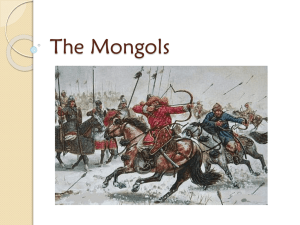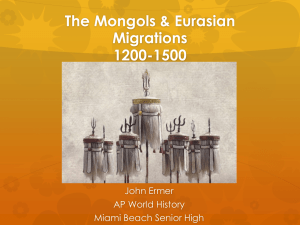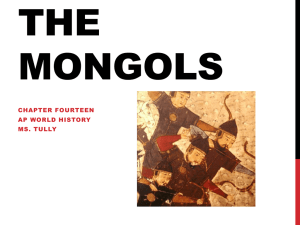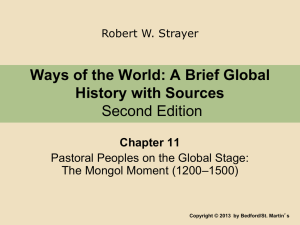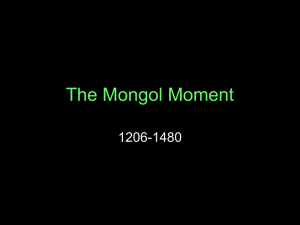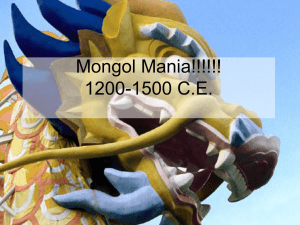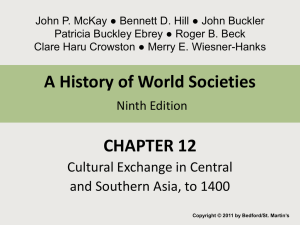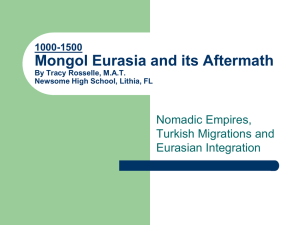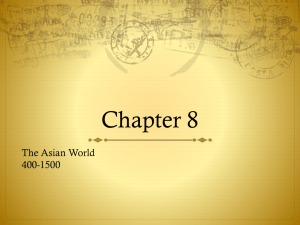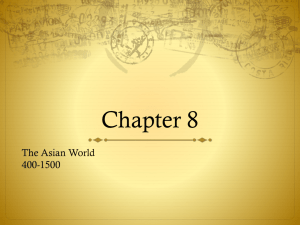The Mongol Empire
advertisement
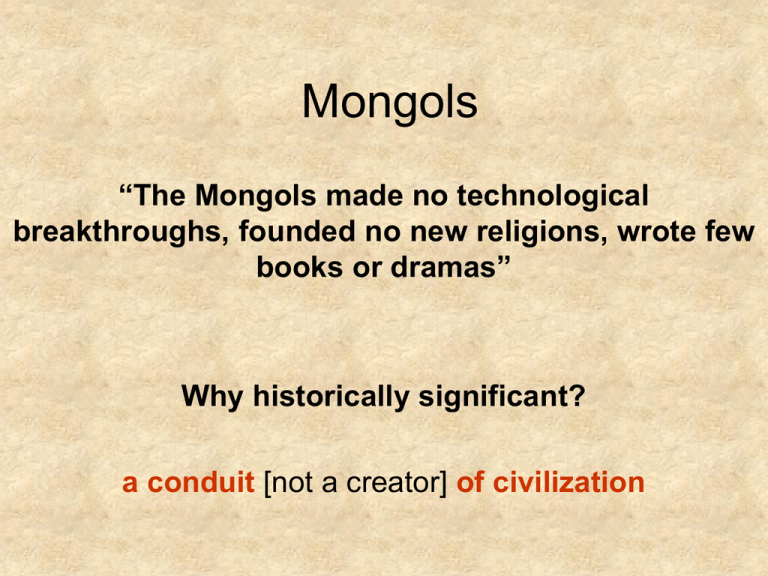
Mongols “The Mongols made no technological breakthroughs, founded no new religions, wrote few books or dramas” Why historically significant? a conduit [not a creator] of civilization The Mongols and Eurasian Empire • Built the largest empire in history stretching from Poland to China • 13.8 million square miles • 100 million people Chinggis/Genghis Khan The Mongol Empire at its height To compare… Imagine if… “the U.S., instead of being created by a group of educated merchants & wealthy planters, had been founded by one of its illiterate slaves, who, by the sheer force of personality, charisma, & determination, liberated America from foreign rule, united the people,… invented a new system of warfare, marched an army from Canada to Brazil, and opened roads of commerce in a free-trade zone that stretched across the continents.” – Jack Weatherford in Genghis Khan A Quick Background… • Nomads • Genghis Khan chosen leader • Need for water leads to conquest - Central Asia lacked rain for agriculture • Greatest Opportunity was trade – horses! Mongols • Declared themselves to be descendents of Huns who founded the 1st steppe empire in late Classical era. • Called “Tartars” especially by Westerners (“people from hell”), though a misnomer: Mongols conquered steppe tribe Tartars, but because so many Tartars rose to prominence in the Mongol Empire, the name became synonymous with Mongols. What were the key factors that allowed fewer than 125,000 nomadic warriors to build the largest empire in world history? • Military prowess • Adaptation of local societies / talents • Timing: void of a really strong leader/empire Impact of the Mongols • “The Mongols created a single economic, cultural, and epidemiological world system” – – – – Mongol Exchange New methods of warfare Trade from Venice to Beijing and beyond Demographic change via the plague and major population shifts – Altered the political histories of Russia, China, Europe – Unparalleled cultural diffusion Russia Western Europe Mongolia Byzantine Empire China Persia India Africa Why were the Mongol armies so successful? • Simple, but effective • All males, 15-60, were eligible for conscription • army was only source of honor • Trained using massive hunts • Great discipline • Equipped for mobility and speed: lightly armored, no supply lines; couriers • Careful planning, reconnaissance, intelligence • Decimal system of organization: arbats (tens), zuuts (100s), myanghan (1000s), tumen (10,000s = roughly a division) • Very good at adapting to various conditions. • Became adept at siege warfare; recruited well; built effective catapults. • Combined various types of armed force: mounted archers, lancers, engineers, rockets, and smoke. Strong Equestrians and Archers • The Mongols were oriented around extreme mobility. They carried their houses with them, drank their own horse's blood to stay alive, and could travel up to 62 miles per day. • They had an elaborate prioritymail-system which allowed orders to be transmitted rapidly across Eurasia. • Mongol archers were very deadly and accurate – Their arrows could kill enemies at 200 meters (656 feet) Psychological Warfare • Genghis Khan used combined fake retreats with accurate Horse Archers to pick off his European enemies. • Genghis Khan slaughtered a few cities, in an attempt to scare all other cities to surrender without a fight. He, being a practical leader, also valued smarts more than bravery • If enemies surrendered without resistance, the Mongols usually spared their lives, and they provided generous treatment for artisans, craft workers, and those with military skills • In the event of resistance, the Mongols ruthlessly slaughtered whole populations, sparing only a few, whom they sometimes drove ahead of their armies as human shields during future conflicts Strategies to create an empire Harnessed the tribe’s tendency for war Organized the tribes Used tactics never before used in battle Used strategy (not just force) to win Genghis Khan • In 25 years, subjugated more land & people than the Romans did in 400 years. • Destroyed LOTS of ‘less important’ cities – often along less accessible trade routes – to funnel commerce into routes that his army could more easily supervise and control. Genghis Khan • Valued individual merit & loyalty • Fighting wasn’t honorable; winning was. So, used any means necessary to win (trickery, etc.) • Conscripted peasants: Mongols just didn’t understand peasants who seemed like grazing animals rather than real humans who ate meat. “They used same terms, precision, & emotion in rounding up yaks as peasants.” • Refugees preceded Mongol attack as people from outlying areas fled to cities for protection but overwhelmed the cities & spread fear • LOVED negative PR: allowed & encouraged true or false stories to be circulated in order instill fear. • Fought on the move: didn’t care if chased or fled (unlike sedentary soldier-farmer), just wanted to kill the enemy. Genghis Khan – innovations • Relied on speed & surprise and perfected siege warfare (not relied on defensive fortifications) • Used resources of land instead of relying on supply train • Allocated fallen soldiers’ share of loot to widow/children (ensured support) • Reorganized army so each unit had a mix of tribal/ethnic peoples and they had to live & fight together ---transcend kinship, ethnicity, & religion. • Religious tolerance • Instituted postal system for communication • Ordered writing system created • Abolished torture & insisted on rule of law (to which even the khan was accountable) Rule in conquered territories Ruthless annihilation of resistance (terror tactics). People were treated well when no resistance. Cities generally left under native governors. Religious tolerance important in consolidating rule, gain support of minorities oppressed by Muslims. • Administration commonly more benign, less corrupt than pre-Mongol government. “Pax Mongolica?” • Under the Mongols, there was unprecedented longdistance trade • Mongols encouraged the exchange of people, technology, and information across their empire • Weatherford: the Mongols were “civilization’s unrivaled cultural carriers…” Marco Polo en route to China Mongol Passport Pax Mongolica Marco Polo traveling the Silk Roads • By the mid 13th c, the family of Genghis Khan controls Asia from China to the Black Sea creating a period of stability during which trade flourishes to new heights along the Silk Routes. Before lots of fighting in East Asia and fighting between Muslims & Christians in the SW Asia, but now stability brings trade in more volume & people who now travel the entire distance. • Encouraged great commercial, religious, intellectual exchange between the East & West. “The Mongols made culture portable: it was not enough to merely exchange goods, because whole systems of knowledge had to also be transported in order to use many of the new products” (e.g. drugs weren’t profitable trade items unless one possessed medical knowledge for their use, so moved Arab doctors to China & vice versa) Pax Mongolica: look at all these routes! Exchanges During the Mongol Era From Europe From Southwest Asia From South Asia From East Asia Honey Horses Glassware Slaves Textiles Rugs Incense Finished iron products Finished gold products Spices Gems Perfumes Textiles Gunpowder Firearms Rockets Magnetic compass Porcelain Silk Maritime Technology Paper Making Printing Tea Christian missionaries Italian merchants European diplomats Muslim merchants Nestorian merchants Muslim diplomats Indian merchants Indian diplomats Buddhist religious objects Chinese bureaucrats Chinese artists, artisans East Asian diplomats Sugar cane Black Death Intellectual Exchanges of Ideas, Art, Architecture, Knowledge was constant The Mongol Drive to the West - Russia and Europe were added to the Mongols’ agenda for world conquest, and subjugating these regions became the project of the armies of the Golden Horde, which drove westward . - Kiev was in decline by the 13th century, and Russia was unable to unite before the Mongols (called Tatars by Russians) - Chinggis Khan’s grandson, Batu, defeated the Russian armies one by one, resisting armies were razed - Kiev was taken by 1240 …very few towns survived (only Novgorod and Moscow because they submitted) Russia in Bondage - The Russians became vassals of the khan of the Golden Horde, a domination which lasted for 250 years - Peasants had to meet the demands from both their own princes and the Mongols, and many sought protection by becoming serfs, changing the Russian social structure until the 19th century - Some cities like Moscow benefited from Mongol rule by increased trade, but when the Golden Horde’s power weakened, it led the resistance - Although Mongols remained active in the region through much of the 15th century, Moscow became the center of political power in Russia - The Mongols influenced Russian military and political organization, but most significantly isolated them from developments in Western Europe did not experience the Renaissance or Reformation Regional Effects: Russia under the “Golden Horde” • In Russia…Mongol forces successfully attacked Russia in 1224 by defeating Kiev Rus. • Destroyed most cities & demanded high tribute. • However, the Mongols left Russia largely to its own devices & few Mongol officials were there (INDIRECT rule). Russia had lots of independent principalities, each required to send tribute …or else. • New places --like Moscow (Muscovy) to the north --began to grow with the Mongols’ implementation of a postal system, financial structures, & census. Moscow became a cultural & economic center. • Armenians, Georgians, & Russians thought Mongols were a punishment from God who “fetched the Tartars against us for our sins.” • Limited Russia’s interaction with Western Europe (e.g. Russia was isolated from the cultural effects of the Renaissance) --a period of cultural decay except in northern Russia. • Lasted the longest of the all the khanates (until 1480) Mongols in Russia Good: •Centralization politically •Protected Russia from attacks (Teutonic Knights) Bad: •Russia cut off from political, economic, and intellectual development The Mongol Interlude in Chinese History • Kubilai Khan, another grandson, moved against the Song in China and by 1271 his dynasty became the Yuan. • Kubilai forbid the Chinese from learning Mongol script, intermarriage was forbidden, and he refused to reestablish exams for civil service. • Despite restrictions, Kubilai was fascinated with Chinese civilization and adopted much of their culture into his court. He built his capital at Tatu in the north, a site occupied by previous dynasties, put the empire on the Chinese calendar, and introduced Chinese rituals and music into his own court. Mongol Tolerance and Foreign Cultural Influence • The Mongol rulers were open to outside ideas and drew scholars, artists, and office seekers from many regions • Muslims were among the most favored, and they brought much new knowledge into the Chinese world • Kubilai welcomed foreign visitors most famous was the Venetian Marco Polo • He was interested in all religions Buddhists, and Latin Christians, Daoists and Muslims were all present at court And according to one Chinese observer: “They smell so heavily that one cannot approach them. They wash themselves in urine…” The Mongols The Good, the Bad & the Ugly THE GOOD (accomplishments & contributions) 1. Military Strategy & Innovation – Cavalry, Horse Archers, surprise attacks, sieges Genghis first needed to disband tribal loyalties 2. eligious Tolerance (converted to all faiths in region except Hinduism) 3. Common Legal Code 4. Utilized skills of conquered peoples – artisans, soldiers THE GOOD (accomplishments & contributions) 5. Discipline, obedience to own laws 6. Mongols were the only group to successfully conquer Russia 7. Created largest continental empire in history 8. TRADE – source of diffusion – goods, ideas & people - under Mongol rule it was less risky Pax Mongolica The Mongol Empire at its height THE BAD – (failures & struggles) • Constant in-fighting for power – “Khan” • Genghis never setup centralized rule, Kublai struggled with it (Yuan Dynasty) • Kublai failed to conquer Vietnam, Burma, Cambodia & Japan • Inability to control China without considerable force • Over-spending Shortly after Chinggis Khan’s death, his empire split into four Khanates THE BAD – failures & struggles • THE PLAGUE!!! • Over-extension • Struggle between nomadic lifestyle and need to settle (centralized government) THE UGLY – (What!?! Those Mongols were CRAZY!!) • Looting & Destruction of Cities • Massacres (1.6 Million in 1 Afghan city, as many as 18.4 Million total killed) • Use of organized tactical terror Khubilai Khan • Genghis Khan’s grandson who ruled entire China and established the Yuan Dynasty in 1279 AD – first conquered north China under the Jurchen, – Then conquered south China under the Southern Song/Sung, • The conquest of China (Southern Song/Sung) began in 1268 and took 11 years to complete, highlighted by – The battle of Xiangyang, which took 5 years (1268-1273) – The battle of Yangzhou, 1 year (1275) – The seize of Hangzhou, the capital city • Song loyalists continued to fight against the Mongols army in the far south until the last emperor perished at sea and the last general lost his life • Khubilai Khan was able to institute Mongolian rule effectively, as evidenced by few major insurrections occurring during his reign Effects on Overland Trade • Linked Christian, Muslim and Chinese worlds in one Pax Mongolica • Encouraged Silk Road trade – Patrols and passports – Paid high prices at Karakorum and financed caravans • Marco Polo (1253-1324) – Traveled with father and uncle to the East, made a fortune, and went back (1271-1295) – Great influence on European attitudes towards the East • New Ideas from China went west: – Paper and paper money, gunpowder, coal, movable type, passports, high-temperature furnaces, medicine, etc. Discussion Question: Do you think that the modern image of Mongols a. is warranted given their history? b. is partially warranted given their history? c. is misleading because they were little different from other pastoralists in world history? d. is the product of the peoples that they conquered writing their history? Discussion Question: For you, which of the following was the most important contribution of the Mongol Empire to world history? a. They constructed the largest Eurasian empire to date. b. They destroyed a series of well-established empires. c. They fostered trade, the spread of disease, and the exchange of crops and technology across Eurasia. d. The disruption of trade caused by the collapse of their empire provided an important incentive for Europeans to take to the seas in an effort to secure sought-after Asian goods. Discussion Question: Regarded as a whole, was the Mongol impact on world history more positive or negative? a. The Mongol impact on world history was more positive than negative. b. The Mongol impact on world history was more negative than positive.

